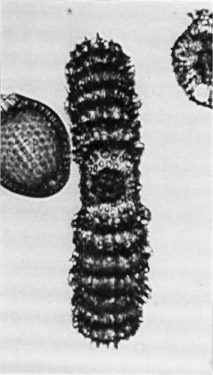 Diartus
hughesi (Campbell and Clark)
Diartus
hughesi (Campbell and Clark) Diartus
hughesi (Campbell and Clark)
Diartus
hughesi (Campbell and Clark)Ommatocampe hughesi Campbell and Clark, 1944, p.23, pl.3, fig.12
Ommatartus hughesi (Campbell and Clark), Riedel and Sanfilippo, 1970, p.521
Diartus hughesi (Campbell and Clark), Sanfilippo and Riedel, 1980, p.1010
Shell generally robust with thick walls and a rough surface. Cortical twin shell approximately cylindrical or with slightly concave sides, bearing numerous circular to subcircular pores of variable size and arrangement. Inner and outer medullary shells spherical, attached to the mid-section of the cortical shell by radial beams. Two to 6 rounded polar caps, which fit against each other, are attached to each end of the cortical shell. Caps may be the same width as the cortical shell or broaden distally. When the distal caps become spongy, however, they are narrower than the cortical shell. In many specimens solid tubercules project laterally from the sides the cortical shell near the polar caps and from the polar caps themselves (Nigrini, unpubl. data).
Length, total, 280 µm, of central section, 48 µm; greatest width (across peripheral arm), 90 µm (Campbell and Clark, 1944).
The cortical shell is approximately cylindrical and the outer medullary shell approximately spherical. The polar caps are multiple (Ommatartus hughesi in Riedel and Sanfilippo, 1978a).
It is distinguished from D. petterssoni by more than half of the skeletal structure at each end of the cortical shell being composed of discrete caps, rather than spongy material (even though the latter may be transversely zoned). It differs from those occasional specimens of Didymocyrtis antepenultima [and D. penultima] that have more than one cap on each pole by the cortical shell being subcylindrical rather than equatorially constricted. It differs from such two-armed porodiscids as Ommatocampe polyarthra Ehrenberg (1872a, p.317; 1872b, pl.6, 3, fig.9) and the form identified as belonging to the "Amphymenium splendiarmatum Clark and Campbell group" by Petrushevskaya (1975, pl.7, fig.1) by having a cortical shell distinct from the medullary shell(s) and caps (Sanfilippo et al., 1985).
The sub-cylindrical cortical shell has a single ring of protuberances at each pole, surmounted by 2-6 polar caps. As in D. petterssoni, the tubercles on the cortical shell are variably developed - in some specimens, practically absent. Also as in D. petterssoni, the cortical shell in some specimens tends to be subspherical (particularly in the early part of the range of D. hughesi).
This species occurs widely in middle late Miocene assemblages. The evolutionary transition to this species from Diartus petterssoni defines the boundary between the Diartus petterssoni Zone and the Didymocyrtis antepenultima Zone. Its morphotypic last appearance marks the top of the Didymocyrtis antepenultima Zone.
This species evolved from Diartus petterssoni and terminates the Diartus lineage.
Additional illustrations can be found in Riedel and Sanfilippo, 1971, pl.1C, figs.17-18; Johnson, 1974, pl.7, figs.8-10; Holdsworth, 1975, pl.1, figs.3-5.